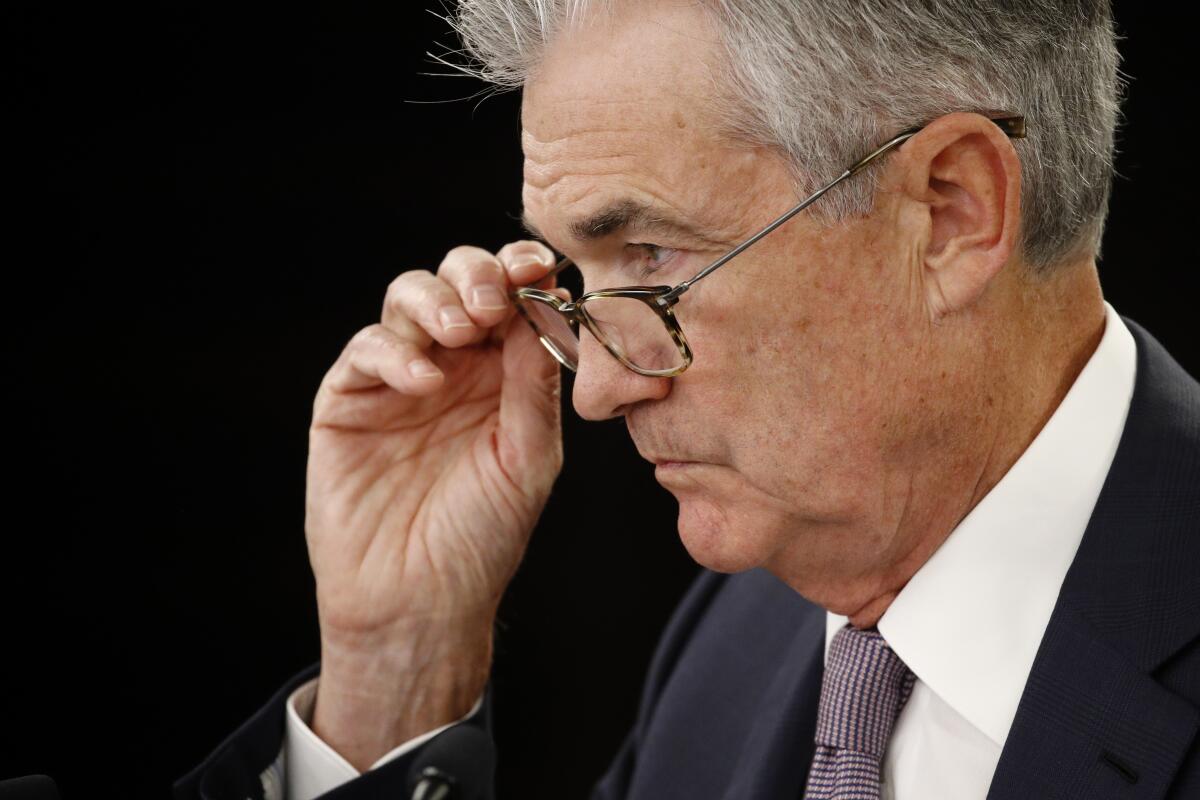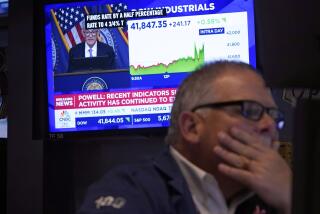The Fed makes emergency rate cut to offset the coronavirus impact, but will it work?

- Share via
WASHINGTON — The Federal Reserve, reacting swiftly to the coronavirus’ damaging blows to the economy, announced a sizable interest rate cut Tuesday — the first such emergency rate action since the Great Recession more than a decade ago.
The Fed’s move — along with a coordinated global economic response reminiscent of the dark days of the 2007-08 financial crisis — gave an initial boost to stocks, with the Dow rising almost 700 points.
But it fell almost as quickly, reflecting the depth of concern about the virus’ potential reach and economic impact, as well as whether lower interest rates or other government actions can help in the face of the mysterious and highly infectious disease.
The Dow ended the day down 786 points, a nearly 3% drop and the ninth decline in the last 10 trading sessions.
The Fed’s half-point rate cut marked a dramatic change from just a week ago when Fed officials seemed content to take a wait-and-see approach. But since then, there has been mounting angst in the United States that the spreading virus could do serious harm to the American economy, as it has in China, where the outbreak began.
Rising numbers of coronavirus cases — and the first deaths — in the U.S. have caused increasing health concerns and deepening pessimism about the economy. A growing number of American companies have warned of lower earnings because of their exposure to China and disruptions to global supply chains, as well as a slowdown in travel and tourism.
“We saw a risk to the outlook for the economy and chose to act,” said Fed Chair Jerome H. Powell, at a news conference shortly after the rate-cut announcement.
President Trump, who has been an ardent critic of his own Fed leader, demanded that the central bank keep lowering rates.
“The Federal Reserve is cutting but must further ease and, most importantly, come into line with other countries/competitors,” he tweeted moments after the Fed announcement. “We are not playing on a level field. Not fair to USA,” he said, in a reference to lower interest rates in other advanced economies. “It is finally time for the Federal Reserve to LEAD. More easing and cutting!”
The Fed’s announcement came as the international group consisting of the United States and six other major advanced economies, referred to as the G-7, issued a statement pledging to use “all appropriate tools” in response to the rising risks of a possible global pandemic.
Although the G-7 provided no specific action plan, Treasury Secretary Steven T. Mnuchin suggested the White House could soon announce steps to help small and medium-sized businesses affected by the fallout from the spreading coronavirus.
Those steps are likely to include regulatory relief and a special lending facility to help offset potential increases in unemployment and bankruptcies, said Joe Brusuelas, chief economist at the accounting firm RSM US.
“It will soon be time for the federal government to bring out its biggest gun: fiscal firepower,” he said.
Powell left open the possibility of additional rate reductions. In a statement approved unanimously, Fed policymakers said they were “closely monitoring developments” of a health crisis that “poses evolving risks to economic activity.”
With the rate cut, the Fed’s main interest rate will be lowered to 1% to 1.25%. Although Powell and his colleagues can knock that down to zero or even into negative territory — which Trump has suggested the Fed do — analysts say lower interest rates by themselves are unlikely to be very effective.
For one thing, it’s not a lack of credit or even cash that is of concern. Many corporations are flush. Rather, the problem is the threat of widespread closings of businesses and consumers staying at home because of travel restrictions or just being afraid to go to malls and public places.
Powell began the news conference Tuesday by stating that the fundamentals of the U.S. economy remain strong, with unemployment very low and job growth solid. He also noted, however, that “we are beginning to see effects on the tourism and travel industries.” And some latest measures of domestic manufacturing and consumer confidence already indicate weakening.
“The biggest concern for me is if there was a substantial drop in consumer spending, which has been the bedrock of the economic expansion,” said Bernard Baumohl, chief global economist at the Economic Outlook Group.
At this juncture, Baumohl doesn’t see the outbreak triggering a recession in the U.S., but no one can say anything very confidently about the outlook.
Atsi Sheth, managing director at Moody’s, welcomed the Fed action and the pledges by others to do whatever it takes to shore up the economy. But ultimately, she said, it’s a medical issue.
“Until the virus itself and the fear of the virus is contained, I think you’re going to see markets and the real economy suffer,” Sheth said.
Powell acknowledged as much, saying that “we do recognize a rate cut will not reduce the rate of infection [and] won’t fix broken supply chains.” Yet he said lower rates should boost consumer and business confidence, and support conditions affecting credit markets and the financial system.
As he has often, Powell insisted the Fed would make decisions without regard to political considerations, responding indirectly to Trump’s repeated harangues for the Fed to do more. Powell declined to say what fiscal policies should be taken but agreed that a multifaceted response was needed in the face of the epidemic.
The Trump administration itself is said to be considering a proposal for a temporary payroll tax cut, something that was a part of the stimulus to combat the Great Recession.
Analysts said that a payroll tax holiday could be effective if consumers should pull back or the economy starts to shed jobs. Job growth has been resilient during the past nearly 11 years of U.S. economic expansion, the longest on record. Other measures that the administration could take include extending jobless benefits and providing aid to states.
The current fractious political climate in an election year could make it difficult for new fiscal policy actions, however.
“The good news is that divided government will make it harder for the president and Congress to enact unneeded stimulus, just trying to get a boost in the economy today just to get to the election,” said Marc Goldwein, senior vice president for policy at the nonpartisan Committee for a Responsible Federal Budget.
“The flip side is it may make it harder to pass a needed stimulus,” he said, although Goldwein expressed confidence that there was increasing bipartisan consensus to act if the economy goes into a downturn.
Congressional leaders are working toward a bipartisan deal on as much as $8 billion in emergency coronavirus spending.
The House and Senate are expected to quickly approve the legislation, which includes funding for the Department of Health and Human Services, which houses the Centers for Disease Control and Prevention and the National Institutes of Health. It also includes money to help develop a vaccine, for protective and medical equipment, as well as aid to state and local governments that have contended with the virus.
“We’re on the way to getting that through the House this week and with cooperation could get it through the Senate as well,” Senate Majority Leader Mitch McConnell (R-Ky.) told reporters after Vice President Mike Pence spoke behind closed doors with senators of both parties Tuesday.
The amount Congress is expected to approve is multiple times more than what the administration initially asked for, although still less than what some health policy experts have said was needed. Democrats have accused Trump of not moving quickly enough to respond to the spread of the virus.
“The most important thing we can do right now is pass a strong emergency supplemental as quickly as possible, so that our federal and state and local health officials have all of the resources they need. This is truly a serious crisis, and we cannot respond on the cheap or at the last minute,” said Democrat Sen. Patty Murray of Washington, whose state has had nine deaths.
For the Fed, the last time it made an emergency rate cut was in late 2008 during the global financial crisis.
The U.S. economy in many ways is stronger to deal with a downturn today. There’s no widespread housing market bubble, and consumers, banks and businesses are not nearly as leveraged and vulnerable to a slowdown.
But as Moody’s Sheth noted, because the Great Recession was financial and economic in nature, monetary and fiscal stimulus went a long way in supporting the economy.
The current crisis, she said, similarly involves global connections, of people, supply chains and financial markets.
“Those linkages are actually spreading both the virus and the fear, and the slowdown in economic activity,” she said. “And it’s not clear how you get immunity from it.”
Times staff writer Sarah D. Wire in Washington contributed to this report.
More to Read
Get the L.A. Times Politics newsletter
Deeply reported insights into legislation, politics and policy from Sacramento, Washington and beyond. In your inbox three times per week.
You may occasionally receive promotional content from the Los Angeles Times.











